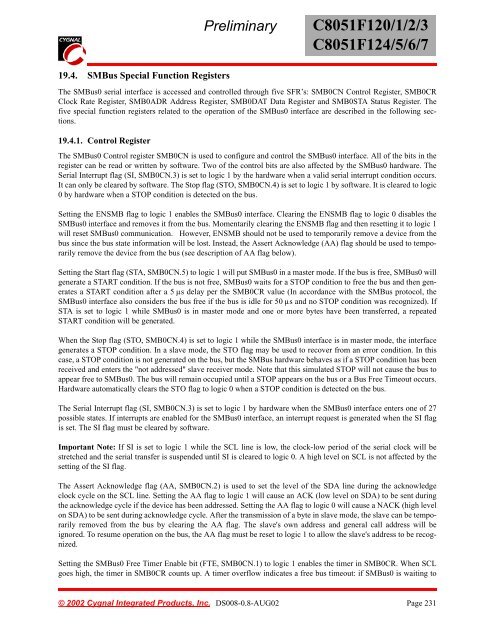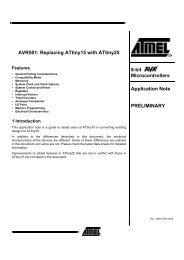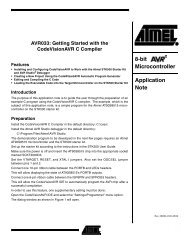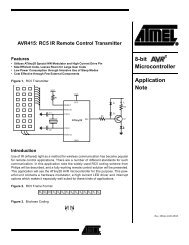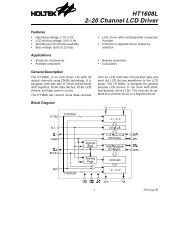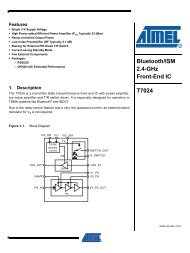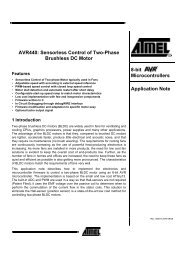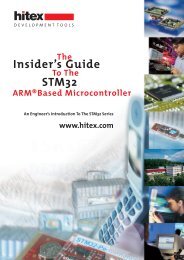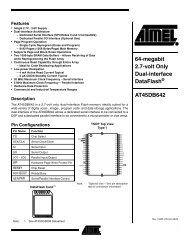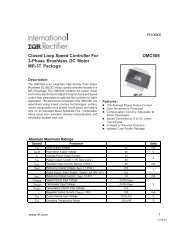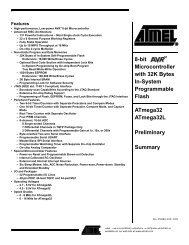Preliminary C8051F120/1/2/3 C8051F124/5/6/7 - KEMT FEI TUKE
Preliminary C8051F120/1/2/3 C8051F124/5/6/7 - KEMT FEI TUKE
Preliminary C8051F120/1/2/3 C8051F124/5/6/7 - KEMT FEI TUKE
Create successful ePaper yourself
Turn your PDF publications into a flip-book with our unique Google optimized e-Paper software.
<strong>Preliminary</strong><br />
<strong>C8051F120</strong>/1/2/3<br />
<strong>C8051F124</strong>/5/6/7<br />
19.4. SMBus Special Function Registers<br />
The SMBus0 serial interface is accessed and controlled through five SFR’s: SMB0CN Control Register, SMB0CR<br />
Clock Rate Register, SMB0ADR Address Register, SMB0DAT Data Register and SMB0STA Status Register. The<br />
five special function registers related to the operation of the SMBus0 interface are described in the following sections.<br />
19.4.1. Control Register<br />
The SMBus0 Control register SMB0CN is used to configure and control the SMBus0 interface. All of the bits in the<br />
register can be read or written by software. Two of the control bits are also affected by the SMBus0 hardware. The<br />
Serial Interrupt flag (SI, SMB0CN.3) is set to logic 1 by the hardware when a valid serial interrupt condition occurs.<br />
It can only be cleared by software. The Stop flag (STO, SMB0CN.4) is set to logic 1 by software. It is cleared to logic<br />
0 by hardware when a STOP condition is detected on the bus.<br />
Setting the ENSMB flag to logic 1 enables the SMBus0 interface. Clearing the ENSMB flag to logic 0 disables the<br />
SMBus0 interface and removes it from the bus. Momentarily clearing the ENSMB flag and then resetting it to logic 1<br />
will reset SMBus0 communication. However, ENSMB should not be used to temporarily remove a device from the<br />
bus since the bus state information will be lost. Instead, the Assert Acknowledge (AA) flag should be used to temporarily<br />
remove the device from the bus (see description of AA flag below).<br />
Setting the Start flag (STA, SMB0CN.5) to logic 1 will put SMBus0 in a master mode. If the bus is free, SMBus0 will<br />
generate a START condition. If the bus is not free, SMBus0 waits for a STOP condition to free the bus and then generates<br />
a START condition after a 5 µs delay per the SMB0CR value (In accordance with the SMBus protocol, the<br />
SMBus0 interface also considers the bus free if the bus is idle for 50 µs and no STOP condition was recognized). If<br />
STA is set to logic 1 while SMBus0 is in master mode and one or more bytes have been transferred, a repeated<br />
START condition will be generated.<br />
When the Stop flag (STO, SMB0CN.4) is set to logic 1 while the SMBus0 interface is in master mode, the interface<br />
generates a STOP condition. In a slave mode, the STO flag may be used to recover from an error condition. In this<br />
case, a STOP condition is not generated on the bus, but the SMBus hardware behaves as if a STOP condition has been<br />
received and enters the "not addressed" slave receiver mode. Note that this simulated STOP will not cause the bus to<br />
appear free to SMBus0. The bus will remain occupied until a STOP appears on the bus or a Bus Free Timeout occurs.<br />
Hardware automatically clears the STO flag to logic 0 when a STOP condition is detected on the bus.<br />
The Serial Interrupt flag (SI, SMB0CN.3) is set to logic 1 by hardware when the SMBus0 interface enters one of 27<br />
possible states. If interrupts are enabled for the SMBus0 interface, an interrupt request is generated when the SI flag<br />
is set. The SIflag must be cleared by software.<br />
Important Note: If SI is set to logic 1 while the SCL line is low, the clock-low period of the serial clock will be<br />
stretched and the serial transfer is suspended until SIis cleared to logic 0. A high level on SCL is not affected by the<br />
setting of the SIflag.<br />
The Assert Acknowledge flag (AA, SMB0CN.2) is used to set the level of the SDA line during the acknowledge<br />
clock cycle on the SCL line. Setting the AA flag to logic 1 will cause an ACK (low level on SDA) to be sent during<br />
the acknowledge cycle if the device has been addressed. Setting the AA flag to logic 0 will cause a NACK (high level<br />
on SDA) to be sent during acknowledge cycle. After the transmission of a byte in slave mode, the slave can be temporarily<br />
removed from the bus by clearing the AA flag. The slave's own address and general call address will be<br />
ignored. To resume operation on the bus, the AA flag must be reset to logic 1 to allow the slave's address to be recognized.<br />
Setting the SMBus0 Free Timer Enable bit (FTE, SMB0CN.1) to logic 1 enables the timer in SMB0CR. When SCL<br />
goes high, the timer in SMB0CR counts up. A timer overflow indicates a free bus timeout: if SMBus0 is waiting to<br />
© 2002 Cygnal Integrated Products, Inc. DS008-0.8-AUG02 Page 231


